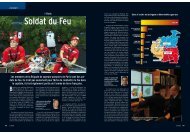Joint Publication 3-13, Information Operations - The Global ...
Joint Publication 3-13, Information Operations - The Global ...
Joint Publication 3-13, Information Operations - The Global ...
Create successful ePaper yourself
Turn your PDF publications into a flip-book with our unique Google optimized e-Paper software.
CHAPTER III<br />
INTELLIGENCE SUPPORT TO INFORMATION OPERATIONS<br />
“To understand human decisions and human behavior requires something more<br />
than an appreciation of immediate stimuli. It requires, too, a consideration of the<br />
totality of forces, material and spiritual, which condition, influence or direct human<br />
responses. And because we are dealing with human beings, the forces which<br />
helped shape their actions must be recognized as multiple, subtle, and infinitely<br />
complex.”<br />
1. Introduction<br />
David Herlihy, <strong>The</strong> History of Feudalism<br />
Like all other aspects of joint operations, IO requires effective intelligence support. IO is<br />
intelligence intensive in particular and therefore successful planning, preparation, execution,<br />
and assessment of IO demand detailed and timely intelligence. This chapter briefly discusses<br />
how intelligence supports the planning and execution of IO.<br />
2. Intelligence Support to <strong>Information</strong> <strong>Operations</strong><br />
Before military activities in the information environment can be planned, the current “state”<br />
of the dynamic information environment must be collected, analyzed, and provided to commanders<br />
and their staffs. This requires intelligence on relevant portions of the physical, informational,<br />
and cognitive properties of the information environment, which necessitates collection and analysis<br />
of a wide variety of information and the production of a wide variety of intelligence products as<br />
discussed below.<br />
a. Nature of IO Intelligence Requirements. In order to understand the adversary or<br />
other TA decision-making process and determine the appropriate capabilities necessary to achieve<br />
operational objectives, commanders and their staffs must have current data. This includes relevant<br />
physical, informational, and cognitive properties of the information environment as well as<br />
assessment of ongoing IO activities.<br />
(1) Physical Properties of the <strong>Information</strong> Environment. Physical properties of<br />
the information environment include people, places, things, and capabilities of information<br />
infrastructure and adversary information capabilities. Examples include:<br />
capabilities.<br />
(a) Geographic coordinates of adversary information infrastructure and<br />
(b) Organization of infrastructure and capabilities as well as identification of critical<br />
links, nodes, and redundant communication infrastructure.<br />
(c) Types, quantity, and configuration of information infrastructure and capabilities<br />
(with specific makes, models, and numbers).<br />
III-1



